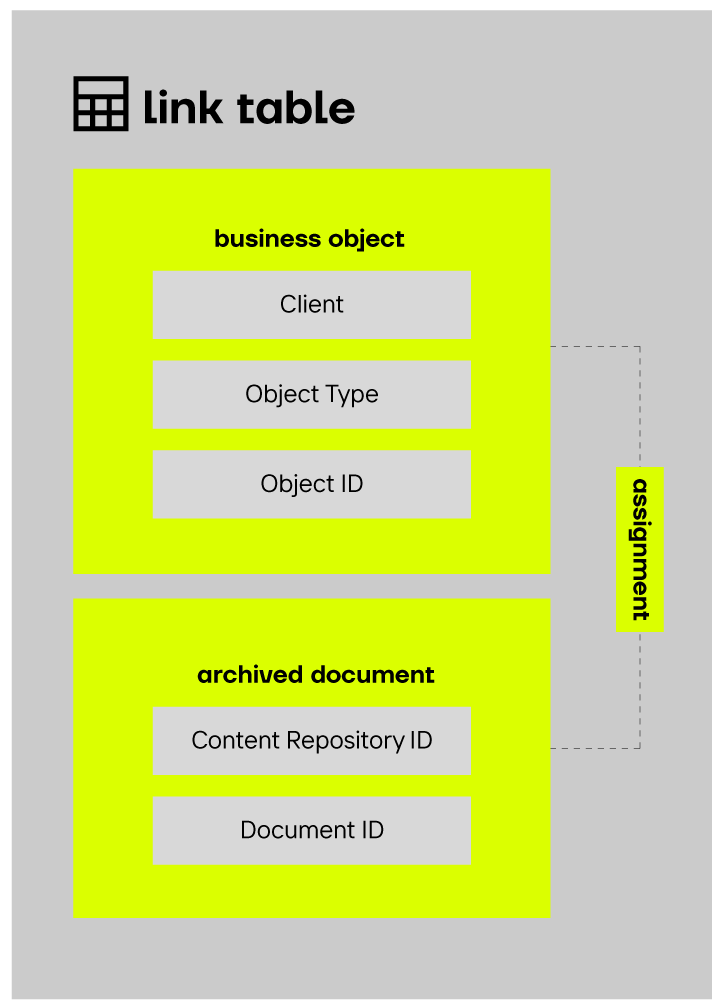What is ArchiveLink?
ArchiveLink is a service provided by the SAP NetWeaver Application Server (previously: SAP Web Application Server). This service links the application documents entered into the SAP ERP system with the associated archived documents. ArchiveLink stores the assignment in a link table. SAP ArchiveLink thus symbolically represents the bridge between the SAP system and the archive storage – and it does so in a permanent fashion, making it perfect for compliant archiving and much more.

For the archive storage itself, SAP ArchiveLink offers two options. The SAP Content Server can be used, although SAP recommends this only for temporary storage. Or you can rely on an alternative archive; however, you should always look for SAP certification in this case. After all, the chosen solution must be able to interact smoothly with SAP ArchiveLink. easy archive for SAP Solutions is one such solution.
What are the advantages of ArchiveLink?
First and foremost, SAP ArchiveLink enables convenient and legally binding archiving of incoming and outgoing documents, and the same applies to table contents as well as print lists. However, ArchiveLink promises two more advantages thanks to the approach described above:
- Advantage 1 – quick access: The contextually embedded, fast and direct access from the document in the SAP system to archived documents simplifies daily work in document-intensive system environments.
- Advantage 2 – advanced searching: SAP ArchiveLink also offers significant added value in the everyday handling of documents. With the help of specific attributes, you can search specifically for archived documents, even directly in the SAP system. Search functions like these eliminate tedious workflows, such as making copies of the originals and carrying out time-consuming searches for process-specific information. In this way, SAP ArchiveLink not only minimizes time-consuming tasks but also increases the efficiency and accuracy of workflows.
How does SAP ArchiveLink work?
There are three key elements of ArchiveLink:
- the selected content repository, i.e. the archive storage location for the documents
- the ArchiveLink link table, including logical assignments between the application documents and archived documents
- the application documents in the SAP system
As a rule, an SAP-certified archive server is used as the content repository for compliant archiving. This is exactly where the archived documents will be located later. The SAP ArchiveLink service is then used to establish the logical link from the application document in the SAP system to the document in the content repository.
What is a Content-Repository?
Such repositories are filing systems that hold your archived documents in a structured way. SAP ArchiveLink provides three options for such a repository:
- as a logical area in the file system of a hard disk,
- as a database or
- as an external archive server
One of these options is selected based on the application. In all cases, however, ArchiveLink ensures structured, secure storage.
The ArchiveLink link table – how it works
Let’s examine a simple example based on an incoming document. As soon as the document reaches the SAP system, an application document and an associated business object are created in SAP.

The business object defines three important parameters that make it unique and identifiable. The ArchiveLink service generates a unique link from these parameters and automatically provides it to SAP applications on request. This makes it a snap to carry out fast searches directly from the applications in the SAP ERP system.
ArchiveLink – in use for over 20 years
This SAP interface has been reliably performing its valuable service since 1996. It does the same within the product world of easy. The interface fulfills two functions at easy:
- On the one hand, ArchiveLink is used for legally-compliant data storage in terms of the statutory retention periods.
- On the other hand, this technology can also satisfy the prerequisites for compliance with data protection regulations.
Both are enabled by easy archive for SAP Solutions, which can be combined with easy WebDAV for SAP ILM if data protection functionality is required.
Is ArchiveLink a service or an interface?
The short answer: Both are true. From the perspective of the SAP system, ArchiveLink represents itself as a service. From the point of view of an application, it is probably more of an interface.
In addition, SAP ArchiveLink has a role to play in the transition to S/4HANA. The aim here is to keep the data volume consumed by HANA’s in-memory database as lean as possible. This is desirable for both performance and cost reasons. In this way, it is possible even before the switch to S/4HANA to determine which data records should be stored in the SAP HANA database in the first place and which should rather be archived in the external archive.
After a good quarter century in practical use, it is worth wondering what the future might hold for the SAP ArchiveLink interface. As recently announced, this interface is no longer supported in the S/4HANA public cloud; for this use case, ArchiveLink is being retired. CMIS (Content Management Interoperability Services) should serve as a suitable alternative here. Unfortunately, this is not yet official, so we will have to wait and see.
Archivelink with EASY Archive for SAP Solutions
Thanks to the ArchiveLink interface, companies can easily integrate easy archive into existing and new IT infrastructures. As a result, companies benefit from compliance and data protection compliant archiving, even easier retrievability and quick access to archived documents in SAP.